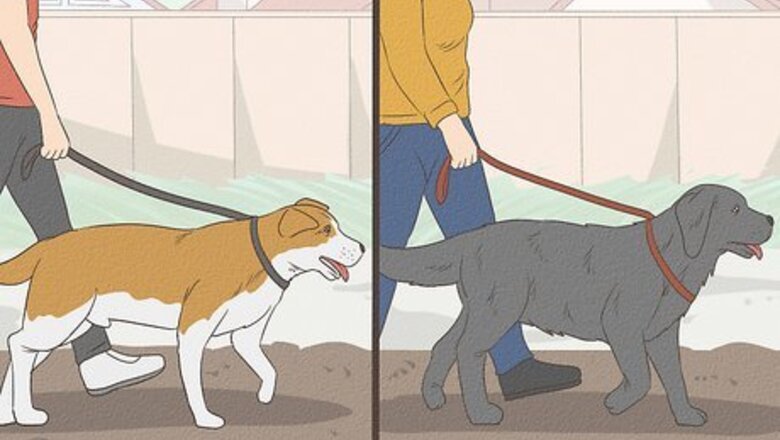
views
X
Research source
We’ll tell you everything you need to know about letting dogs meet for the first time, as well as how to introduce a new dog to your home. We’ll also give you an overview of canine body language so that you can keep control of the situation at all times.
- Walk the leashed dogs parallel and 20 ft (6.1 m) apart until they appear calm and pay more attention to their human than the other dog.
- Gradually close the distance until the dogs can walk side-by-side without obsessing over each other’s presence. This might take a few walks, so stay patient!
- Let the dogs meet and sniff each other for a few seconds at a time, keeping them on-leash until they show signs of relaxation or play, like a raised behind.
Introducing Dogs to Each Other
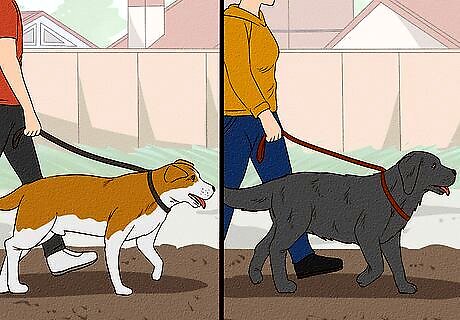
Walk the dogs parallel but 20 ft (6.1 m) apart from each other. Recruit a friend or family member to walk one dog while you walk the other. Start in a neutral space that neither dog is territorial of, like a park, friend’s yard, or a quiet street. Walk the dogs at least 20 ft (6.1 m) apart in the same direction for 10-15 minutes, or until the dogs lose interest in each other, or are relatively calm. If either dog starts barking, pulling, or staring at the other dog, you’ve gotten too close too soon. Separate them by another 20 ft (6.1 m) until they calm down. Be sure to put each dog on a leash for this. Try to avoid holding the leash too tight, though, since this can aggravate the dog and make them aggressive. Reward the dogs for calm behavior with training treats and lots of verbal praise. And be patient! The slower you go, the smoother the introduction will be.
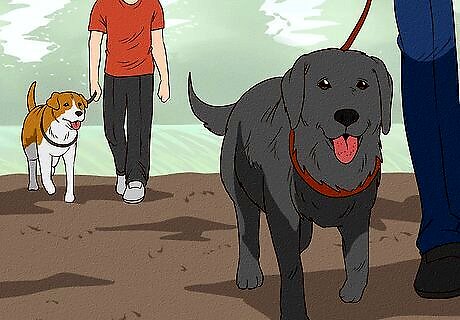
Decrease the distance between them by 3–5 ft (0.91–1.52 m) at a time. If both dogs are calm, and can take treats and walk as usual while paying more attention to their humans than each other, bring them closer together by about 3–5 ft (0.91–1.52 m), then continue walking. Close the distance this way, slowly shortening the gap, until the humans can walk next to each other with the dogs on either side, then with one dog behind the other, then with the dogs side-by-side and 3–5 ft (0.91–1.52 m) apart, without trouble. It might take more than one session for both dogs to be calm in each other’s vicinity. You may need to board the new dog with a friend and repeat the walk a couple hours later, or the next day.

Let the dogs meet up close while monitoring their body language. Once the dogs can walk parallel without showing any signs of aggression or nervousness (like low growling, stiffening, or hard stares), bring them closer to let them sniff each other. Let the dogs meet for a few seconds at a time before walking away, then coming together again. Keep the leashes loose to avoid prompting aggressive behaviors, and monitor the dogs closely to ensure they’re getting along. Note that some dogs may react differently while on a leash versus off a leash. If either dog displays aggressive behaviors like lunging while on a leash, it’s best to recruit the help of a trainer to first eliminate this aggression.
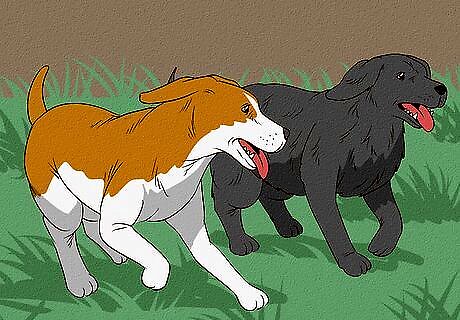
Allow the dogs to meet for a few minutes at a time while off-leash. If everything is going well, let the dogs meet off-leash in a fenced area, but still keep the leashes attached in case you need to separate them again if they start to show pushy behavior like mounting or nipping. Let them interact for a few minutes at a time before leading them away from each other. Some dogs may need more than one session of this in order to get comfortable with the new dog. Keep the leashes attached to both dogs, just in case you need to grab and separate them for any reason.

Repeat the process 1-2 times a day until both dogs behave calmly. Some dogs have very little trouble making new friends, and will play or be relaxed around their new companion with no problems (in which case, you’re good to go). Others might take a few sessions of walking parallel and gradually coming closer together to warm up to a strange dog, and it may take a couple weeks to accomplish. Let the dogs take the lead, and avoid forcing them together too soon if they’re uncomfortable or nervous. Always end the introduction on a good note, when both dogs are happy, which might mean stopping their play a bit early. Offer them treats at the end of the introduction to build a positive association with meeting the new dog.
Bringing a New Dog into Your Home

Put away any of the other dog’s possessions. Before you introduce your new dog to your home for the first time, scan your home for any toys, food bowls, blankets or beds, or other things your current dog might be territorial about. These can cause conflict between the two dogs, especially if your current dog tends to be possessive or is prone to resource guarding. Reintroduce these toys one at a time over the course of the next few weeks. Also, separate any other pets or young humans into closed-off rooms. You can introduce cats to your dog later, after the dog has settled in.
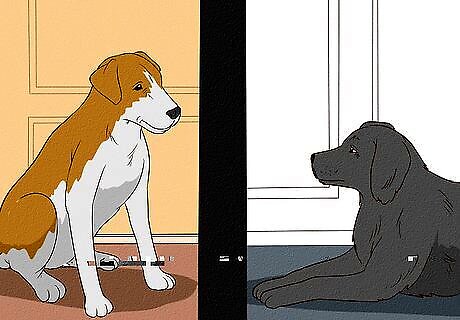
Place the dogs in separate, adjacent rooms to explore. Let the dogs roam free in adjacent rooms, but separated by a baby gate or a closed door so that they can get used to each other’s company and scents. When both dogs have calmed down (it may take several hours), remove the gate or the door to let them interact within your home, while paying close attention to their body language to make sure they get along. Reward them for positive interactions, like sniffing or play, with treats and praise. It may take a few days or even weeks for both dogs to get comfortable with each other in the same space. Keep them in separate rooms while allowing them to periodically meet in the meantime. It may help to keep both dogs’ leashes on while inside to more easily separate them if they show aggression. If either dog shows signs of nervousness or aggression, separate them into different rooms again and let them interact in another few hours, or even in a day or two if the aggression is severe.

Establish and stick to a daily routine to settle in. Your new dog may be a bit nervous or unsure for the first few weeks, so it’s important to stick to a routine. This helps them learn the rhythm of your house, and to feel more comfortable with a more predictable environment. Feed the dogs, walk them, and put them to bed at the same time each day to build a stable environment. Try to wait to introduce the dog to visitors until it’s comfortable at home. Also, feed the dogs in separate rooms to deter resource guarding or possessive behavior. It can take some dogs a while to really get comfortable in a new home, and they might be rather difficult in the meantime. Stay calm and patient, and give them a few weeks to show you their true selves.
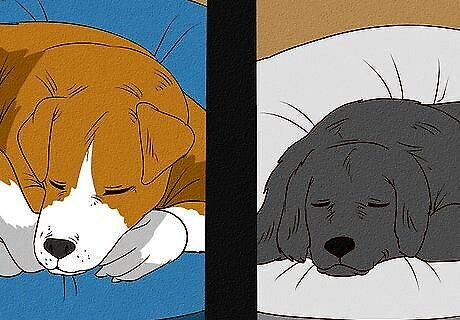
Keep the dogs separate when you leave the house. Even if the dogs get along swimmingly while you’re at home, it’s best to keep them kenneled or shut in separate rooms whenever you leave them unsupervised for the first few weeks. This prevents aggression or other negative behaviors while you’re away, which can undo your hard work in introducing them. Give each dog their own bed and separate toys, so that both feel comfortable and established in your home.
Understanding a Dog’s Body Language

Positive body language A happy dog has a relaxed and loose, but attentive, posture. Their ears are in a natural position (raised but not alert), and their eyes are open, but not too wide. They’ll often wag their tails and adopt a “play” stance with their bottoms raised and their mouths open or panting, but without bared or snarling teeth. Happy dogs may also bark or vocalize when excited, but these will be accompanied by other relaxed signs like a wagging tail.
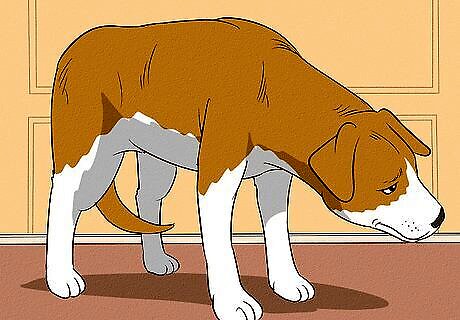
Anxious body language Nervous dogs often keep their heads low with their ears pulled back. They may yawn frequently, lick their lips, or tuck their tails between their hind legs. Often, they’ll sit and raise one paw, lay down, or make themselves small and turn their heads away to avoid eye contact. A little nervousness is totally normal when introducing two dogs. If your dog appears anxious, give them a break from the other dog until they’re relaxed and confident again.

Aggressive body language Aggressive dogs may stand with a stiff, alert posture with their weight forward and attention zeroed in on the other dog. Their tails are often raised and stiff, with their ears either upright at attention or laid back on their heads. They may snarl or bare their teeth, with their lips drawn back. Aggressive dogs might also stand with their legs bent, or cower on the ground.




















Comments
0 comment